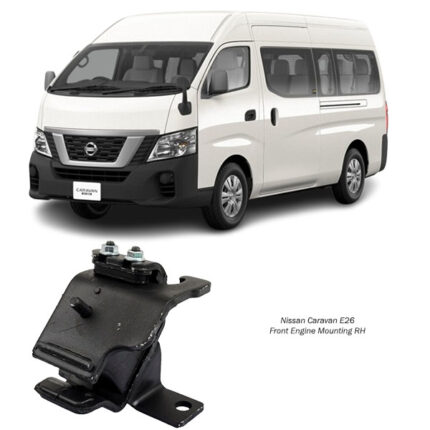Get Nissan Caravan E26 Front Engine Mounting LH 11220-3XN1A in Kenya
Among the many critical components under the hood, few are as underestimated—and as essential—as the engine mount. In particular, the Front Engine Mounting LH (Left-Hand) plays a key role in keeping the engine securely in place while reducing noise and vibration during operation.
Although it’s small compared to the engine itself, this mount carries significant responsibility. Let’s explore what the Front Engine Mounting LH is, how it works, signs of wear, and why it’s crucial to a smooth, safe, and reliable driving experience.
🔍 What Is the Front Engine Mounting LH?
The Front Engine Mounting LH is a structural component located on the left-hand (LH) side of the engine bay, securing the engine to the chassis or subframe. Its job is not only to hold the engine in place, but also to absorb engine movement, reduce vibration, and isolate noise from reaching the cabin.
It typically consists of:
-
A metal bracket or frame
-
A rubber or hydraulic bushing
-
Mounting bolts or studs
Some designs are purely rubber-based, while others incorporate hydraulic fluid for enhanced damping performance.
⚙️ How It Works
Engines generate torque, vibration, and movement—especially during acceleration, deceleration, and gear changes. Without engine mounts, this motion would transfer directly to the chassis, making the vehicle unstable and uncomfortable to drive.
The Front Engine Mounting LH functions by:
-
Securing the engine on one side while allowing controlled flex
-
Absorbing engine vibrations and road shocks
-
Maintaining proper alignment between the engine and transmission
-
Reducing stress on other engine components like hoses, wiring, and exhaust
By doing so, it contributes to a smooth and quiet ride, as well as protecting critical engine parts from stress and misalignment.
🧱 Types of Engine Mounts
While the LH front mount is location-specific, its design can vary depending on the performance needs and engine layout. Common types include:
1. Rubber Engine Mounts
Made of a rubber cushion bonded between two metal plates. The rubber acts as an insulator to dampen engine movement and vibration.
Pros:
-
Cost-effective
-
Quiet operation
-
Low maintenance
Cons:
-
Wear out faster
-
Less effective under high torque or heavy loads
2. Hydraulic Engine Mounts
These mounts use fluid-filled chambers to provide additional damping. They are commonly found in more refined or performance-focused setups.
Pros:
-
Superior vibration control
-
Better performance under dynamic load
-
Smooth ride quality
Cons:
-
More expensive
-
Can leak over time
3. Active/Electronic Mounts
Advanced systems that adapt to engine load and driving conditions using sensors and actuators. Rare in standard setups but used in some high-tech applications.
Pros:
-
Optimized comfort
-
Smart damping based on RPM and load
Cons:
-
Expensive
-
Requires electronic management
🔧 Why the Left-Hand (LH) Side Matters
The LH front engine mount often bears unique stress compared to other mounts. Depending on engine layout, the LH side may be closer to the accessory drive, battery, or suspension components—each of which affects vibration and stress points differently.
-
It may experience more torsional stress if located near the transmission or driveshafts.
-
It can be exposed to heat from nearby components like the exhaust manifold.
-
Its failure may lead to engine tilting or alignment issues that affect other systems.
This makes the LH front mount a critical component to inspect and maintain regularly.
🚨 Signs of a Failing Engine Mount
Engine mounts don’t last forever. Over time, the rubber degrades, hydraulic mounts may leak, and bolts can loosen. A failing front engine mount LH will often exhibit the following symptoms:
1. 🎯 Excessive Engine Movement
If the engine rocks noticeably during acceleration, gear shifts, or braking, the LH mount may be worn or broken.
2. 🗯️ Unusual Vibrations
More engine vibration than usual—especially when idling—can mean the mount is no longer absorbing movement effectively.
3. 🧭 Clunking or Banging Noises
A loud clunk when shifting gears or driving over bumps may be caused by the engine making direct contact with the chassis due to mount failure.
4. 🧰 Misalignment of Other Components
A tilted or misaligned engine can lead to stress on hoses, belts, wiring, or even the exhaust system.
5. 👀 Visible Wear or Damage
Cracked rubber, loose bolts, or collapsed mount geometry during inspection are all red flags that the mount needs replacement.
🔁 When to Replace the Mount
Engine mounts typically last between 60,000 to 100,000 kilometers, though this varies with driving habits, engine size, and road conditions. Replacement is necessary when:
-
You notice any of the above symptoms
-
During engine or transmission replacement
-
As part of a scheduled engine overhaul
-
If damage is found during a suspension or engine bay inspection
It’s also recommended to replace mounts in pairs (left and right) to maintain balance and consistency—especially if they are the same age.
🔩 The Replacement Process
Replacing the front LH engine mount requires some care, since it supports part of the engine’s weight. Here’s a general overview:
-
Lift and safely support the vehicle.
-
Support the engine with a jack or engine support bar to relieve pressure from the mount.
-
Remove nearby components if they obstruct access (e.g., battery tray, brackets).
-
Unbolt and remove the old mount.
-
Install the new mount, ensuring proper torque on all bolts.
-
Recheck engine alignment and reconnect any removed parts.
-
Test for vibrations or unusual engine movement during idle and acceleration.
Professional installation is advised, especially for hydraulic or active mounts, to ensure safety and precision.
🛡️ Maintenance Tips
Engine mounts are generally low-maintenance, but you can extend their life with a few best practices:
✅ Avoid Aggressive Driving
Sudden acceleration, engine braking, and rough gear changes place extra stress on mounts.
✅ Check Mounts During Servicing
Ask for a mount inspection during routine maintenance like oil changes or suspension work.
✅ Watch for Fluid Leaks
Leaking hydraulic mounts often go unnoticed until performance is affected.
✅ Mind the Engine Bay Temperature
Overheating can degrade rubber components. Keep cooling systems in check to protect mounts.
📌 Conclusion
The Front Engine Mounting LH may be one of the quieter players in the engine bay, but its role is foundational. It secures the engine, protects against vibration, and maintains harmony between moving components. Whether it’s rubber or hydraulic, the health of this mount directly impacts driving comfort, engine longevity, and safety.
Keeping an eye on wear signs and replacing it when needed ensures your engine stays stable, your ride remains smooth, and your vehicle performs the way it should.
Follow us on Facebook for more parts.





Reviews
Clear filtersThere are no reviews yet.